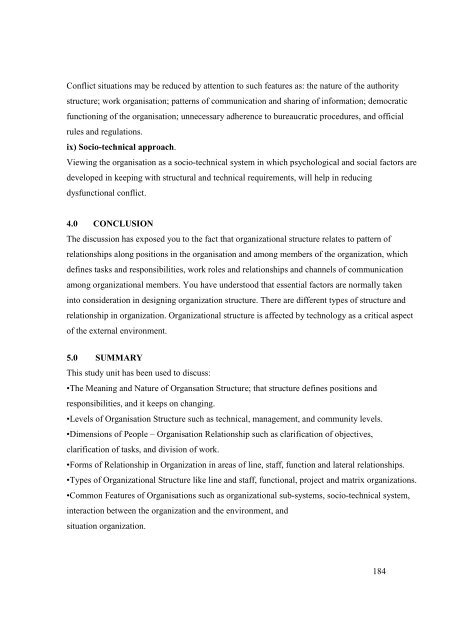HCM 433 MANGEMENT AND ORGANIZATIONAL BEHAVIOUR.pdf
HCM 433 MANGEMENT AND ORGANIZATIONAL BEHAVIOUR.pdf
HCM 433 MANGEMENT AND ORGANIZATIONAL BEHAVIOUR.pdf
You also want an ePaper? Increase the reach of your titles
YUMPU automatically turns print PDFs into web optimized ePapers that Google loves.
Conflict situations may be reduced by attention to such features as: the nature of the authority<br />
structure; work organisation; patterns of communication and sharing of information; democratic<br />
functioning of the organisation; unnecessary adherence to bureaucratic procedures, and official<br />
rules and regulations.<br />
ix) Socio-technical approach.<br />
Viewing the organisation as a socio-technical system in which psychological and social factors are<br />
developed in keeping with structural and technical requirements, will help in reducing<br />
dysfunctional conflict.<br />
4.0 CONCLUSION<br />
The discussion has exposed you to the fact that organizational structure relates to pattern of<br />
relationships along positions in the organisation and among members of the organization, which<br />
defines tasks and responsibilities, work roles and relationships and channels of communication<br />
among organizational members. You have understood that essential factors are normally taken<br />
into consideration in designing organization structure. There are different types of structure and<br />
relationship in organization. Organizational structure is affected by technology as a critical aspect<br />
of the external environment.<br />
5.0 SUMMARY<br />
This study unit has been used to discuss:<br />
•The Meaning and Nature of Organsation Structure; that structure defines positions and<br />
responsibilities, and it keeps on changing.<br />
•Levels of Organisation Structure such as technical, management, and community levels.<br />
•Dimensions of People – Organisation Relationship such as clarification of objectives,<br />
clarification of tasks, and division of work.<br />
•Forms of Relationship in Organization in areas of line, staff, function and lateral relationships.<br />
•Types of Organizational Structure like line and staff, functional, project and matrix organizations.<br />
•Common Features of Organisations such as organizational sub-systems, socio-technical system,<br />
interaction between the organization and the environment, and<br />
situation organization.<br />
184
















